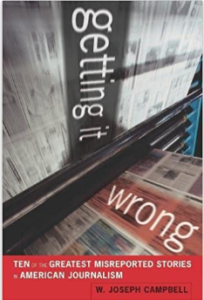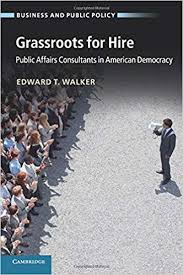
BOOK REVIEW: “Grassroots for Hire: Public Affairs Consultants in American Democracy” (Cambridge University, 2014)
I am grateful to Professor Edward T. Walker.
He’s brought us an eye-opening piece of scholarship about a hidden world – the world of elite public affairs consultants and their big money clients.
Walker’s book: Grassroots for Hire: Public Affairs Consultants in American Democracy is based on meticulous research and tons of interviews.
It’s a splendid platter of data.
According to Walker, some 40% of massive Fortune 500 corporations use PA consultants, ostensibly to find people who already would be supportive of the client’s agenda, and mobilize them, using the same tool kit that real grassroots groups use.
But Walker observes that “a lack of disclosure about the funding” makes it difficult for citizens to interpret why they’re being mobilized.
Walker notes that PR companies justify their shadowy work with excuses like “…if the campaign doesn’t involve fraud or misrepresentation of citizens’ authentic views, then it shouldn’t matter who helped those individuals or groups find their voice.”
But Walker believes that the selective targeting of activists creates inequality. Campaigns can falsely appear to represent “the broader public interest,” when in fact, campaigns may engage a public that’s already over-represented.
Walker says “the strategy of funding third party advocacy without disclosure” has exploded since the 1960s and he states repeatedly in his book that this large industry is under-investigated and under-examined.
One sad outcome is that true grassroots groups face skepticism over whether or not they are bona fide.
Walker writes, “campaigns that are less than fully transparent about their sponsorship may decrease public trust in advocacy groups in general” with the result that much advocacy today is believed to be untrustworthy, inauthentic, and covertly funded.
Walker notes, however, that all is not lost. Critical observers who ask tough questions about funding can expose bad behavior.
Walker includes an example from 2006. A popular blog called Wal-Marting Across America, written by “Jim and Laura,” detailed the couple’s travels in an RV and their encounters with Walmart workers who always said good things about their employer. But it was soon disclosed that Walmart was paying for the RV rental, gas and fees for writing the blog. The stunt is now a case study.
When exposed, fake grassroots is considered abhorrent, and a lesson is sent out to other conglomerates.
Grassroots for Hire is a dry academic textbook and Professor Walker is very buttoned-up in his delivery of the facts. But it’s precisely the book’s neutral voice and non-inflammatory style that contributes to its value.
—————
BOOK REVIEW: Getting it Wrong: Ten of the Greatest Misreported Stories in American Journalism (University of California Press, 2010)
Joseph Campbell’s book neatly lances ten myths about American journalism. Each myth is the subject of its own chapter, and they’re all fascinating!
But one myth stands out for Levees.org––the myth that journalists rose up and provided spectacular reporting right after Hurricane Katrina.
Chapter ten of “Getting it Wrong” is about the rampant unprofessionalism and breaches of ethics displayed by reporters and journalists in the weeks––especially the first five days––after the levees broke.
According to Campbell, “Katrina’s aftermath was no high, heroic moment in American journalism. The coverage was in important respects, flawed and exaggerated… and made it seem as though the city were a haven for lurking criminals waiting for the opportune moment to inflict violence on others.”
Campbell notes that the over-the-top reporting had devastating consequences, the immediate one being delay of life saving aid. By reporting unsubstantiated rumors of violence, journalists “unwittingly helped slow an already slow response and further wound an already wounded population.”
In the data-dense chapter, Campbell debunks journalistic error after journalistic error and in the end, makes it clear that an entire city and its people were impugned.
Campbell does note––rightly––that coverage in a time of disaster is often in error. But he notes that a disaster is an “untenable excuse when thinly documented accounts are shown to be false or exaggerated.” He also quoted the House select committee as noting,
“skepticism and fact checking are easier when the sea is calm, but more vital when it is not.”
The House report soundly criticized the media for its poor post-levee failure reporting, but, as Campbell notes, this wasn’t something you heard in the media.
We were pleased to see that Campbell bemoans how “American journalism loves giving prizes––to its own.” He notes the large number of prizes given to local New Orleans reporters who, we now know, wrote outright false stories and/or drew wrong conclusions.
With the benefit of hindsight, Levees.org feels it is clear that unverified reporting by major media after Hurricane Katrina “set the stage” for the dismissal of the New Orleans people.
In the seven days after the storm, and subsequently, through the next seven weeks, the poor reporting described by Campbell caused a distinct and irreparable prejudice toward a population that had suffered immeasurably.
In Levees.org’s view, it set the stage for the Army Corps of Engineers’’ soon-to-be-launched P.R. campaign to blame the city’s inhabitants for the failures of the federal agency’s levee building.
Then, when top officials with the Army Corps’ blamed the flooding on local levee officials rather than itself, the foundation of shame was already in place.
Campbell’s book is a giant step in correcting that wrong.
—————–

BOOK REVIEW: “In the Shadow of Statues: A White Southerner Confronts History” (Viking, 2018).
Former Mayor of New Orleans Mitch Landrieu tells a story about how he grew up in a household where one was always expected to attempt to look at issues from the other person’s point of view. As Landrieu explains it, this trained him to look to understand the nature of the pushback he received his entire life. In Landrieu’s case, the “pushback of his lifetime” was national disagreement over four Reconstruction-era statues.
I learned something reading the book that I did not know, namely that Landrieu had researched the proposed plan to relocate four statues away from prominent public spaces long before the official removal of the Confederate flag from the top of the statehouse in Charleston in July 2015.
In his book, Landrieu says “history is purposefully false,” and he rails against the idea of sanitizing history. I read the book because I wanted to see how he framed the story of the New Orleans Flood of 2005. Too many people have characterized the flooding as due to a monster storm (false), due to a city that lay completely below sea level (false) or due to local corrupt officials (false). I was not disappointed.
On page 99, Landrieu wrote, “the levees, we learned later from federal investigations, had been compromised through faulty design by the Army Corps of Engineers.”
On pages 112-113, he writes about how neighborhoods – black, white and mixed – were affected by water at equal proportion.
“We shouldn’t blame people for losing what they had, when the levees broke and destroyed their homes because of massive human error by the Army Corps of Engineers, a federal agency.”
Not everyone will agree on Mitch Landrieu’s legacy as the mayor of New Orleans. But to me, Mitch Landrieu is not a hypocrite on the subject of history being sanitized and purposefully false.
This engaging book will likely be read for decades. And I am glad Landrieu’s facts were right about the flooding of New Orleans during August of 2005.
—-
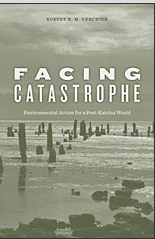 BOOK REVIEW: “Facing Catastrophe: Environmental Action for a Post-Katrina World” (Harvard University Press, May 2010)
BOOK REVIEW: “Facing Catastrophe: Environmental Action for a Post-Katrina World” (Harvard University Press, May 2010)
Founder Sandy Rosenthal provides commentary on “Facing Catastrophe: Environmental Action for a Post-Katrina World” (Harvard University Press, 2010) by Robert Verchick J.D., the Gauthier-St. Martin Eminent Scholar of the Loyola University New Orleans College of Law.
Portions of Rob Verchick’s book, recently released on paperback, are required reading at several law schools and graduate programs in disaster studies. But the book also makes the economics of environmentalism remarkably accessible to lay people. With use of illustrative personal experiences, Verchick explains the important distinction between manmade infrastructure (e.g. buildings and bridges) and natural infrastructure (soil, wetlands and forests). And within this analysis, we find that the infrastructure of the Louisiana coast provides not just goods, but also services, most significantly, storm surge reduction.
Using examples from disasters all over the world, Verchick lays out how laws allow for valuable natural infrastructure to be squandered yet at the same time, “a government would never allow private parties to dismantle bridges for cheap steel.” Verchick analyzes the failure of environmental policy in protecting natural infrastructure and for imagining proactive solutions. A high price leads to judicious use and perhaps conservation whereas a low price, he says, leads to gluttony.
But our personal favorite portion of “Facing Catastrophe” is chapter nine where Verchick neatly lances a harmful myth pushed in the immediate political aftermath of the New Orleans Flood – that environmentalists blocked the Army Corps of Engineers’ original plans for peripheral barriers and forced the federal agency to choose a second inferior design that could not protect the city.
Verchick describes how the myth developed; then he sliced and diced the myth by telling the full and true story concluding that “it is unfair and destructive to cast responsibility for the failure of the New Orleans levee system on this small band of activists and a popular environmental law.”
Furthermore, Verchick reveals another “broken link in the causal chain,” namely that Corps officials interviewed by the GAO office a month after the storm “believe that flooding would have been worse if the original (barrier) plan had been adopted.”
Robert Verchick’s book, Facing Catastrophe has joined Levees.org’s must-read list of Katrina books.
——-
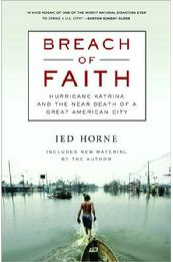 BOOK REVIEW: “Breach of Faith” (Random House, June 2006)
BOOK REVIEW: “Breach of Faith” (Random House, June 2006)
Levees.org, a New Orleans-based non-profit formed after Hurricane Katrina with a mission of raising awareness about the nation’s levee systems, has released its third book review by its founder Sandy Rosenthal that address the New Orleans flooding of August 2005.
Rosenthal provides the following commentary on the “Breach of Faith: Hurricane Katrina and the Near Death of a Great American city” (Random House, 2006).
Author Jed Horne has shown his journalistic genius in converting a mountain of facts and into an exciting page turner. By blending real life stories with one of the century’s most memorable – and horrific – events, Horne is likely responsible for ascertaining that the Flooding of 2005 is remembered with accuracy.
Though filled with myriad details before, during, and after the catastrophic flooding, Horne infused those details with spirit and at times gentle humor. For example, in describing what Gregory Richardson, a frightened homeowner could see from the roof of his flooded home, Horne writes “…he heard a sound, the tapping and ripping sound of another roof being breached from the inside out, and in due course the house two doors down hatched another human…”
There are numerous colorfully presented documented references that explain not only the what and why of the horrific flooding and also the intense voluminous disinformation about it that pervaded the media after the fact.
I noted with interest an observation by Horne about a Post-K “…systemic disinformation campaign….putting falsehoods into the minds of a reliable stable of ….stalwarts and then making them available to the media as talking heads.” This is interesting because in one instance, Horne seems to have become ensnared in the very trap he observed.
In Chapter 17, Horne describes how in the mid 1980s, the Army Corps had “fought hard and unsuccessfully for lakefront gates” and under pressure from the local Orleans Levee Board were “condemned to build” a second rate system which later failed during Katrina.
Horne relied on the word of a past Orleans Levee Board president, and the only documented references were from a Los Angeles Times article dated Christmas Day 2005. I called the reporter about the specific story who confirmed that his only documentation was notes taken
verbally from a Corps spokesperson – which he “could not provide.”
Bottom line, the assertions and conclusions do not have the necessary documentation, and both are clearly refuted by Douglas Woolley and Leonard Shabman in the Hurricane Protection Decision Chronology, Jun 2007, page 82. This distinction is critical because when the London and 17th Street canal floodwalls failed in 2005 resulting in the drowning deaths of over 600 people, the local New Orleans officials were frequently blamed, without factual basis. As put forth by Woolley/Shabman, the Corps looked at the relative costs and merits and found that the higher canal walls were more economical. The Corps chose to build the higher walls — and to not build the gates — and did so without reservations.
Nonetheless, in closing, “Fine job!” to Jed Horne for his book which is a joy to read, even by someone like me, who thought I would never find joy in reading anything about the Army Corps of Engineers’ civil engineering mistakes exposed during Katrina.
And it is precisely because this book will likely be read for decades, that we hope Horne considers updating Chapter 17 in future editions.
——
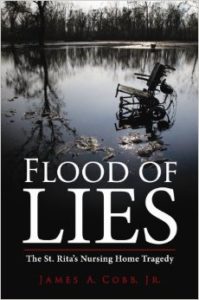 BOOK REVIEW: “Flood of Lies” (Pelican Publishing, July 2013)
BOOK REVIEW: “Flood of Lies” (Pelican Publishing, July 2013)
Upon the release of “Flood of Lies,” just shy of eight years since Hurricane Katrina, the American citizen at large does not understand that the devastating flooding in New Orleans was primarily due to the failure of levees and floodwalls designed and built by the Army Corps of Engineers. Without giving away the exciting shock ending, “Flood of Lies” is about the only jury who decided who was responsible for the worst civil engineering disaster in United States history.
The events that unfolded after the levees broke on August 29, 2005 need to be remembered. So I am glad that James Cobb wrote a book about it, and I expect that “Flood of Lies” will be read and appreciated for decades to come.
Click here for full book review.
——
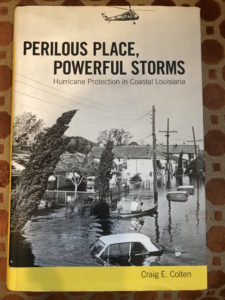 BOOK REVIEW: “Perilous Place, Power Storms: Hurricane Protection in Coastal Louisiana” (University of Mississippi Press, September 2009)
BOOK REVIEW: “Perilous Place, Power Storms: Hurricane Protection in Coastal Louisiana” (University of Mississippi Press, September 2009)
Craig E. Colton’s new book presents a massive amount of important data on the manmade vulnerability of coastal Louisiana. In meticulous detail, the author explains how engineering mistakes, funding battles, and newly imposed law requirements resulted in an inadequate and incomplete flood protection system when Katrina arrived in August
2005.
But because the book may often be referenced in the years to come, it is important to point out some undocumented passages and unfounded conclusions regarding the Army Corps of Engineers and the flood protection structures they built in New Orleans.
On page 51, the author asserts that, in the late 1970s, a federal court “forced the Corps to either abandon” its plan for huge barrier structures east of New Orleans or do “additional environmental analysis.” While its certainly true that on Dec 7, 1977, the court did prohibit those gates, there is no documentation that the court “forced” the Corps to abandon their gates or do a study. Furthermore, this assertion is completely refuted in the Katrina Canal Breaches Consolidated Litigation Dismissal Order, Jan 2008, pages
6-12.
This distinction is very important because post Katrina, when history showed that the Corps ultimately elected not to implement the gate structures, environmentalists were frequently blamed, without basis, for the catastrophic flooding of New Orleans.
Similarly, on page 78 and 127, the author asserts that the Corps of Engineers chose to raise the height of the London, Orleans and 17th Street canal floodwalls “despite misgivings” and that the Corps had “initial preference” for gated structures at the mouths of the three canals. And, on page 127, the author says the “overwhelming local preference for building higher canal walls led to their construction.” Again no documentation is presented to support any of these assertions and conclusions. And all of these assertions are refuted by Douglas Woolley and Leonard Shabman, Hurricane Protection Decision Chronology, Jun 2007, page 82.
This distinction is also very important because post Katrina, after it was shown that the outfall canal walls failed catastrophically and killed over 600 people, the local New Orleans officials were frequently blamed, without any factual basis.
We do note that Professor Colten acknowledged in his introduction that the original version of this book was done under contract with the US Army Corps of Engineers history office. This gesture of transparency is commendable as accepting funding form the Corps of Engineers has a certain appearance of non-impartiality.
We also commend the author for neatly lancing a persistent myth about New Orleanians by pointing out that Louisiana had a significantly higher flood insurance subscription rate Pre Katrina than the national average.
Professor Colten has provided a large volume of important data. We expect Perilous Place, Powerful Storms to be referenced often but with caution regarding the undocumented passages and unfounded conclusions noted.

